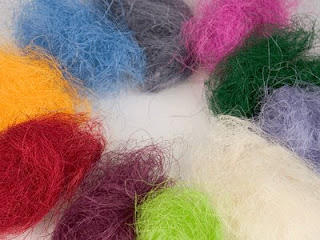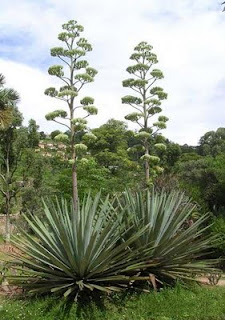
A short while ago I bought a packet of coloured Sisal fibres to add to some office flower displays. I wanted to use the Sisal for support and to add a little something unusual. While trying to separate the bundle in to smaller useable amounts, I was reminded how extremely strong the strands are. Even as small an amount as two or three fibres is very difficult to break by hand and I had to use scissors.
Sisal fibres are very long, often over 1m, and because of this were used historically to make twine and rope. The fibres come from the leaves of a type of Agave, Agave sisalana. They originated in Mexico and were introduced to Florida, the Caribbean islands, Brazil, Tanzania, Kenya, and Asia in the late 19th century. Commercial propagation started in the 1930s.
The fibres are extracted by crushing and thrashing the leaves with the waste pulp being washed away. The waste can be over 95% of the plant material and recently some attempts have been made to improve economic viability with a power plant being developed using biogas from the waste material.
World production of Sisal and a similar agave fibre, henequen, is estimated at around 300 000 tonnes. The major producers are Brazil (120 000 tonnes), Tanzania (30 000) and Kenya (25 000). Brazil exports around 100 000 tonnes of raw fibre and manufactured goods, particularly rope to the USA. Kenya exports around 20 000 tonnes and Tanzania 15 000 tonnes.
Sisal or Manilla rope is traditionally used as tug of war rope. There are rules set by the Tug Of War Association ( yes, there is one!) regarding the use of the rope and how it is held. Nylon should never be used as Tug Of War rope as it stretches and in extreme cases can snap and cause injury. There is a recorded case of two men having their arms cut off by the rebounding force of a nylon rope that snapped during a Tug Of War match.
Agaves make a dramatic display when planted in to the right plant container. Care should be taken when handling the leaves as most have sharp spikes along the edges. In the current health and safety environment I would think tha t they could cause problems in a garden that has public access unless a large warning sign has been erected nearby!
t they could cause problems in a garden that has public access unless a large warning sign has been erected nearby!
Sisal fibres are very long, often over 1m, and because of this were used historically to make twine and rope. The fibres come from the leaves of a type of Agave, Agave sisalana. They originated in Mexico and were introduced to Florida, the Caribbean islands, Brazil, Tanzania, Kenya, and Asia in the late 19th century. Commercial propagation started in the 1930s.
The fibres are extracted by crushing and thrashing the leaves with the waste pulp being washed away. The waste can be over 95% of the plant material and recently some attempts have been made to improve economic viability with a power plant being developed using biogas from the waste material.

World production of Sisal and a similar agave fibre, henequen, is estimated at around 300 000 tonnes. The major producers are Brazil (120 000 tonnes), Tanzania (30 000) and Kenya (25 000). Brazil exports around 100 000 tonnes of raw fibre and manufactured goods, particularly rope to the USA. Kenya exports around 20 000 tonnes and Tanzania 15 000 tonnes.
Sisal or Manilla rope is traditionally used as tug of war rope. There are rules set by the Tug Of War Association ( yes, there is one!) regarding the use of the rope and how it is held. Nylon should never be used as Tug Of War rope as it stretches and in extreme cases can snap and cause injury. There is a recorded case of two men having their arms cut off by the rebounding force of a nylon rope that snapped during a Tug Of War match.
Agaves make a dramatic display when planted in to the right plant container. Care should be taken when handling the leaves as most have sharp spikes along the edges. In the current health and safety environment I would think tha
 t they could cause problems in a garden that has public access unless a large warning sign has been erected nearby!
t they could cause problems in a garden that has public access unless a large warning sign has been erected nearby!
